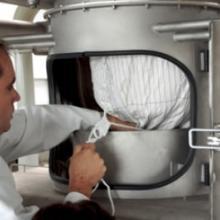Process for feeding mixers
Processed powders: Potato flakes, semolina, salt, breadcrumbs
The customer’s production issue
The client is one of the European leaders in the food industry marketing fresh pasta, rice, couscous, semolina, sauces and prepared meals. As part of their industrial development and production capacity increase, the client company wanted to develop a new stuffing production workshop for one of their sites. This involved adding solutions for the unloading, transfer, storage and batch dosing of bulk raw materials to supply two mixers producing stuffing.
The project objectives:
- Achievement of production capacity targets for mixers using pneumatic transfer devices and dose preparations in masked time
- Integration of unloading and dosing stations in an existing room with limited space and operator access for cleaning and maintenance of equipment
- Minimize the risk of product contamination
- Process safety
- Ergonomics
- Operator safety
- Hygienic design of equipment allowing cleanability and easy access by personnel for maintenance
The list of processed ingredients is as follows: potato flakes, breadcrumbs, semolina, salt, etc. The entire installation is subject to ATEX 22 standards.
The Palamatic Process Solution
To meet the needs and requirements of the customer, Palamatic Process has implemented several solutions including a big bag emptying phase, a storage and dosing phase and a transfer phase by mobilizing powder handling equipment from our equipment range.
1. Bulk bag emptying stations
The big bag emptying solution offered by Palamatic Process consists of two FIBC EasyFlow® unloading stations with unlacing cabinets to limit dust emissions and promote the flow of products.
The positioning of the bulk bag is carried out using an electric hoist. The parts in direct contact with the product are in 304L stainless steel for the semolina and potato flakes and in 316L for the salt.
A vibrating screen is installed to reinforce process safety on each of the big bag emptying stations to prevent the passage of foreign bodies.
Buffer hoppers are positioned under each station and equipped with access hatches for cleaning procedures. Sluice valves are then used to supply the pneumatic transfer circuits.
2. Powder storage and batch dosing unit
The customer wanted minimum storage to guarantee the uninterrupted supply of the production line and limit the frequency of reloading the raw materials. Therefore, high-capacity cyclo-filters from Palamatic's CYS® range were installed on a platform above the weigh buckets. Each cyclo-filter is equipped with a drain valve and each supply circuit is fitted with an in-line magnetic separator on the transfer pipes to capture ferrous metals. The parts in contact with the semolina and potato flake lines are made of 304L stainless steel and 316L stainless steel for the salt processing line.
The raw materials are then prepared in three weigh buckets, one for the potato flakes, one for the semolina and one for the salt. The amounts are made automatically in these weigh buckets according to the pre-programmed recipes.
The materials are then transferred by tubular screw conveyors for the main ingredients - semolina and potato flakes (precision +/- 500g) - or by a screw feeder for salt (precision +/- 200g). The selected powder dispenser is the D11 model from the Palamatic range.
The doses are then collected in a common 316L stainless steel hopper for transfer to the customer's mixers.
3. Unit for transferring raw materials to mixers
The common hopper, having collected the powder doses for the desired recipe, is equipped with a sluice valve for the extraction of the materials. A continuous pneumatic transfer system via a 316L stainless steel cyclo-filter, located above the production workshop, allows the transport of the material.
A gravity discharge pipe placed between the sluice valve at the outlet of the cyclo-filter and the mixers channels the product into the downstream process equipment. The chute is equipped with a gravity switch to select the appropriate mixer to be filled.



















